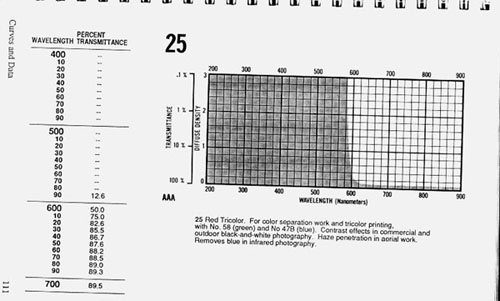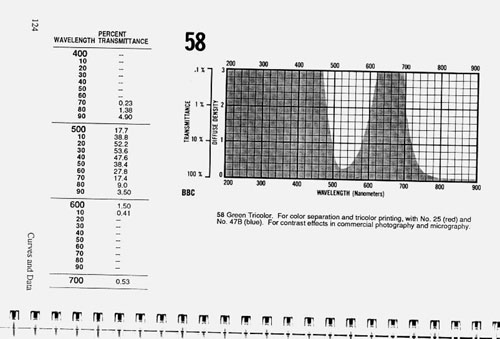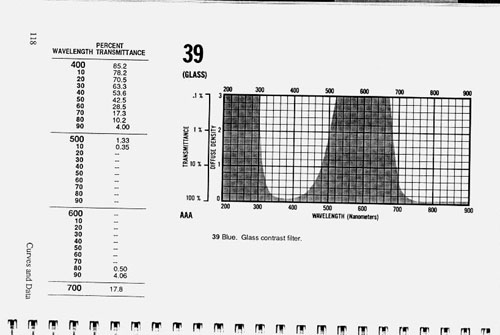
| MadSci Network: Physics |
Hi, Clayton!
The short answer is "it doesn't"!
I'd have to know some more about what you are calling a "blue filter" before I could give you an exact explanation of the phenomenon you are seeing. (Not to be nit-picky, but "blue" is a human perception. I'd need to know what wavelengths are passed and rejected by your filter, and how this is accomplished. The process can be pretty complex.) I can give you some things to think about as you look for your solution, though.
First, the good news: your "red" filter is working normally if it passes a beam from a ruby laser. (Let's assume "red" = 650nm wavelength. Had you specified a diode laser we'd have had to consider "multi-mode" , or multi-wavelength emissions. ) Now for the bad news: I think your "green" filter might be "sick"! (Or, at least, it's not designed to block red at the wavelength of your laser. Try another filter if you can get one.)
I scanned some pages from the Kodak Photographic Filters Handbook (© Eastman Kodak Company. Library of Congress Catalog Number 90-80512, ISBN 0-87985-658-0) to help you visualize what I'm talking about. (Please, excuse the quality. I was in a bit of a hurry after work.) These are graphs of the "performance" (transmittance vs. absorbance) of some common photographic filters:

Number 25 is a Red Tricolor Filter. If you draw a vertical line at 650 nm, you'll find only about 13% of incident 650nm light is absorbed. (The dark area indicates absorbed wavelengths.) Now let's look at a green filter…

Number 58 is a Green Tricolor. Note that if you draw a line up from 650nm it stays in a dark part of the graph. None of the "red" 650nm light should get through this filter. (The one you are using may be shifted in one direction, or another, allowing 650nm light to pass.)
Now, for the blue…

Of course, I was in such a hurry, I missed getting the Blue Tricolor! (I think it's number 47B?)
Even so, this Number 39 Blue Glass Filter will do. The 650nm wavelength is totally absorbed, which is what I assume is happening with your blue filter. This is what happened with the green filter above, and what should have happened -to a greater, or, lesser degree - with your green filter.
What happens when your laser's light is absorbed? As in many laser applications, heat can be generated. What happens after THAT is also dependent upon the type of filter you use. The red and green filters above are examples of "gel" filters. If your laser is powerful enough, you'll probably melt your gels, or, maybe, start a fire. The glass filter might heat up, and eventually even shatter. (One of several reasons it's good to wear proper safety goggles around laser equipment.)
Another type of filter, called a "dichroic" filter, is often used in laser applications. This type of filter reflects rather than absorbs light, so heat isn't as great a concern. (You can sometimes tell a filter is dichroic if it reflects colors complimentary to incident light. The surface will often reflect funny colors under "normal" lighting conditions. You may have seen examples of this in some types of costume jewelry. Just don't rely on this as an absolute indicator!) However, a powerful enough laser can damage even these optics.
There's a lot of "cool science" to learn about in your question, but I didn't want to get too technical. (Your students probably don't want to read the 1000+ pages of "Photochemistry" a friend loaned me today.) The material is there, however, replete with explanations of all the chemistry, quantum mechanics, etc. I'd be happy to pass it along, or, do more research for you, should you require. Just e-mail me at mwnet@swbell.net, or, mweyeric@cpicorp.com. I've enjoyed thinking about your question, and hope you'll keep me updated as to your findings!
Some links you might find helpful:
MadSci Archive Answer re. Filters, etc. : http://www.madsci.org/posts/archives/mar98/891233341.Ph.q.html
VERY BEST link for learning about light, color, photography, digital imaging, etc. There's info on filters here, too. (Perfect presentation for students. There are activities and suggestions for educators, too. Look at all the modules!) : http://www.kodak.com/US/en/digital/dlc/index.jhtml
Godzilla, Barney, and ALL the Pokemon characters vs. THIS laser…fair fight? (Nope!) http://lasers.llnl.gov/lasers/target/novatour/
Ask "Sam" about Lasers! (Includes "DIY projects, and parts sources.) : http://www.misty.com/~don/lasersam.htm
"Dichroic Filter" defined: http://www.its.bldrdoc.gov/fs-1037/dir-011/_1607.htm
P.S. - Thanks to my friend Bill C. for loaning me the Kodak Filter guide, the Photochemistry book, and his MONSTER brain!
Try the links in the MadSci Library for more information on Physics.